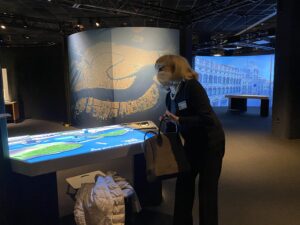Advancing public understanding of sea-level rise
Museum exhibits can be a unique way to communicate science concepts and information. Recently, MIT faculty have served as sounding boards for curators at the Museum of Science, Boston, a close neighbor of the MIT campus.

Professor Emerita Paola Malanotte-Rizzoli inspects the displays created by Iconem, a startup whose mission is digital preservation of endangered World Heritage Sites. The firm took detailed 3D scans and images of Venice to put together the displays and video. (Photo courtesy of Paige Colley)
Professor Emerita Paola Malanotte-Rizzoli in the Department of Earth, Atmospheric and Planetary Sciences was asked to consult on the Museum of Science’s newly opened exhibit, “Resilient Venice: Adapting to Climate Change.”
The exhibit focuses on Malanotte-Rizzoli’s hometown, a city known for flooding. Built on a group of islands in the Venetian Lagoon, Venice has always experienced flooding, but climate change has brought unprecedented tide levels, causing billions of dollars in damage.
One of the plans Venice has implemented to address the flooding is the MOSE system — short for Modulo Sperimentale Elettromeccanico, or the Experimental Electromechanical Module. The MOSE is a system of flood barriers designed to protect the city from extremely high tides. Construction began in 2003, and its first successful operation happened on Oct. 3, 2020, when it prevented a tide 53 inches above normal from flooding the city.
The barriers are made of a series of gates, each 66 to 98 feet in length and 66 feet wide, which sit in chambers built into the seafloor when not in use to allow boats and wildlife to travel between the ocean and lagoon. The gates are filled with water to keep them submerged; when activated, air is pumped into them, pushing out the water and allowing them to rise. The entire process takes 30 minutes to complete, and half that time to return to the seafloor.
The MOSE system is only one of many plans taken to mitigate the rising water levels in Venice and protect the lagoon and the surrounding area, and this is an important point for Malanotte-Rizzoli, who worked on the project from 1995 to 2013.
“It is not the MOSE or,” she emphasizes. “It is the MOSE and.” Other complementary plans have been implemented to reduce harm to both economic sectors, such as shipping and tourism, as well as the wildlife that lives in the lagoons.
Paige Colley | Department of Earth, Atmospheric and Planetary Sciences
This article first appeared in the Summer 2022 issue of Science at MIT.